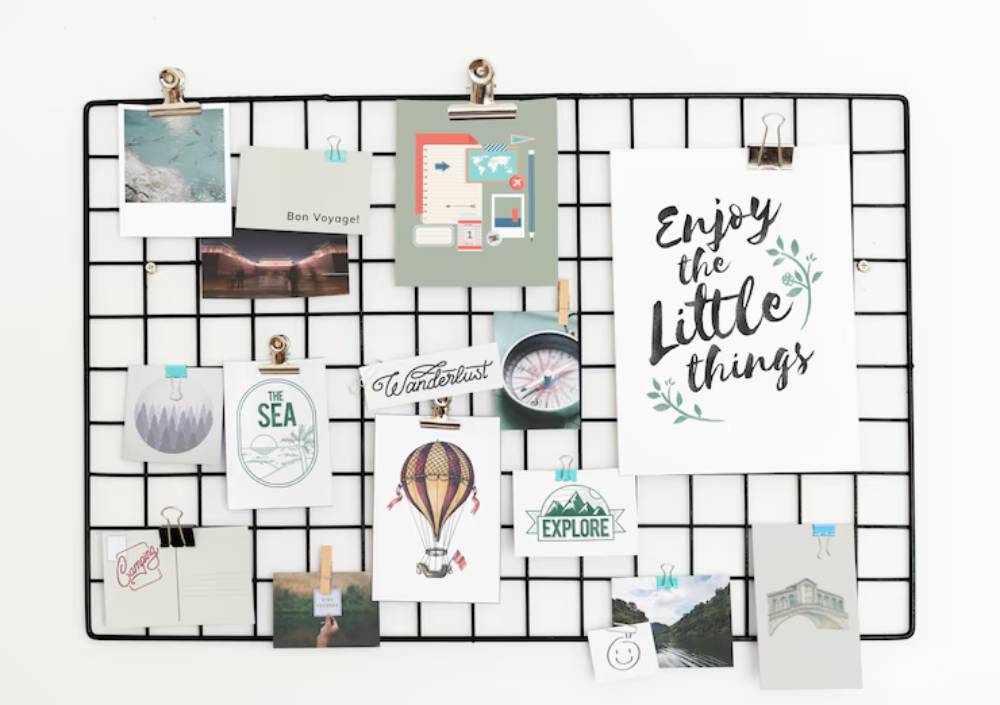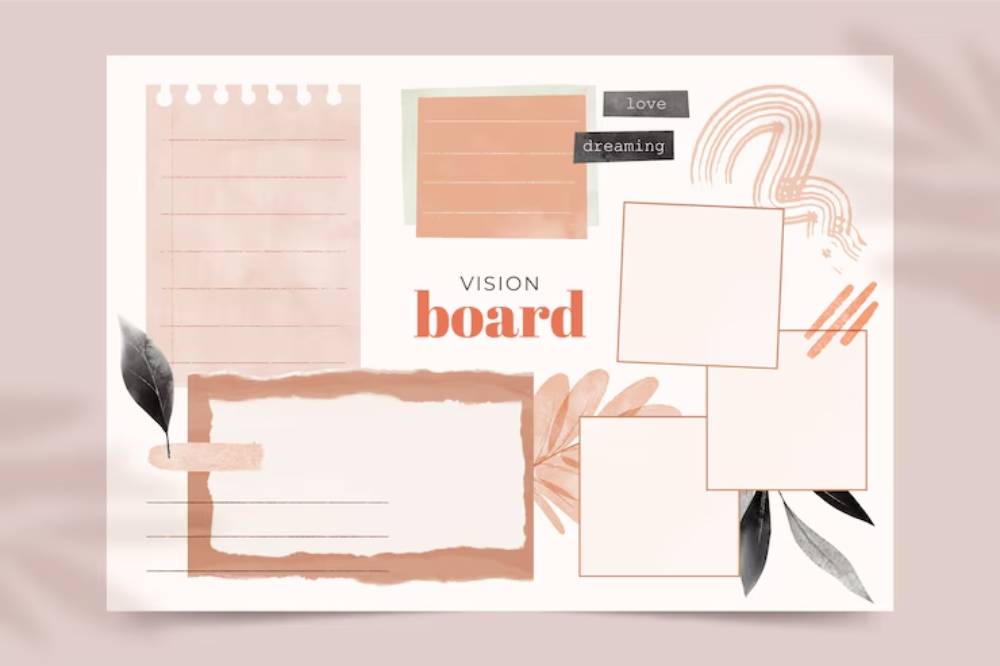The Personal Development Blog

Breaking Down Life Areas for Vision Board Planning
So, the decision’s been made: you’re creating a vision board. You’ve got your scissors, a stack of magazines or digital tools queued up, maybe even a warm cup of tea to keep the vibe cozy. But then… blank space. Lots of it. And that familiar voice in your head asking, Where do I even start?
Enter the concept of vision board categories—a way to organize the beautiful chaos of your goals into meaningful, digestible sections. Because let’s be honest life isn’t just about one thing. It’s a mosaic of desires, responsibilities, dreams, and seasons. And when building your board, acknowledging the different life areas makes it all feel a lot more intentional—and a lot less overwhelming.
Let’s walk through how to use personal goal mapping to bring clarity and purpose to your board. By the end, you’ll have a roadmap for turning that blank canvas into a living reflection of your whole life—not just one shiny corner of it.
Why Break Your Vision Board Into Categories?
The short version? It brings balance.
When you break your board into categories, you make space for all the parts of you—your career goals, your relationship intentions, your health priorities, your spiritual growth. You’re saying “These things matter too.” And in a world that loves to over-prioritise hustle or aesthetics, that’s powerful.
A life areas board:
- Helps you identify blind spots
- Shows how interconnected your goals are
- Encourages holistic growth
- Makes the board easier to design and understand
- Ensures emotional, mental, and physical goals all have a seat at the table
In short, it’s a kind of self-respect. A way of saying, I’m more than just one dream.
The Core Vision Board Categories
Let’s get into the core life areas most people include in their personal goal mapping. You can mix, match, rename, or adapt them to suit your life—but here’s a great starting framework.
1. Career & Work
Ah yes, the place we spend most of our time.
In this category, consider:
- Career advancement (promotion, job switch)
- Creative projects or businesses
- Work-life balance goals
- Leadership or visibility goals
- Learning new skills
Images might include a dream office space, a public speaking stage, or someone confidently holding a mic. Don’t just show the job—show the feeling.
2. Finances & Abundance
Money. Wealth. Security. This category often carries a lot of emotional weight, so make it empowering.
Think:
- Saving goals
- Debt freedom
- Investing or passive income
- Generosity or philanthropy
- Financial independence
Symbols like piggy banks, gold hues, stacked coins, or affirmations like “I manage money with clarity and ease” work beautifully here.
3. Health & Wellness
Not just gym goals. Think full-body vitality.
This might include:
- Movement routines
- Nutritional shifts
- Mental health care
- Sleep improvements
- Hormonal balance
- Healing from chronic illness
Try using imagery that evokes energy, peace, or strength—like nature walks, nourishing meals, or joyful movement.
4. Relationships & Love
From romantic partnership to chosen family to new friendships—this category is about connection.
Include:
- Communication growth
- Finding or nurturing love
- Boundaries and trust
- Building community
- Parenting intentions
Photos of couples, group laughter, soft touches, or relationship affirmations are great choices.
5. Personal Growth & Learning
This one’s for the inner work.
Consider:
- Mindset shifts
- Confidence building
- Emotional healing
- Reading goals or courses
- Identity evolution
Use open books, sunrise imagery, self-reflection quotes, or symbolic visuals like mirrors or butterflies.
6. Spirituality & Purpose
A deeply personal space that can mean very different things depending on your beliefs.
You might include:
- Meditation or mindfulness goals
- Connection to source, nature, or spirit
- Practices that ground you (like journaling or breathwork)
- Discovering purpose
Visuals: candles, hands in prayer, full moons, ocean scenes, or sacred symbols.
7. Home & Environment
Your space shapes your state. This area reflects your desire for comfort, organisation, or aesthetic peace.
Think about:
- Moving to a new space
- Redecorating or decluttering
- Creating a sanctuary
- Hosting or building a family home
Imagery might include interiors, cosy corners, plants, or warm lighting.
8. Adventure & Travel
You’re allowed to dream beyond your city limits.
This category might include:
- Destinations on your bucket list
- Cultural exploration
- Nature immersion
- Spontaneous getaways
- “Digital nomad” lifestyle goals
Visual cues? Airplanes, maps, oceans, mountain trails, or sunsets viewed from somewhere far away.
9. Fun, Play & Creativity
Not everything has to be so serious. Make room for play.
Goals here might include:
- Exploring hobbies
- Making art for fun
- Dance, music, crafting
- Lighthearted experiences
Don’t skip this one. Joy is not extra—it’s essential. Choose imagery that makes you smile without explanation.
Structure a Life Areas Board
Once you’ve chosen your categories, you’ll want a structure that supports visual clarity. Here are a few layout ideas to explore:
Grid or Block Format

Create sections (like a 3×3 grid) where each square holds one life category. Great for symmetry and clean visuals.
Sunburst Style
Centre your board with a core word or centrepiece image, and branch out with categories like sunrays.
Need help choosing that centre? Check out Creating a Centrepiece Image for Your Vision Board.
Layered Collage by Zones

Use colour-coded paper or borders to group areas in a collage-style layout. This balances creativity with order.
Making Each Category Emotionally Real
Don’t just drop in random Pinterest photos. Choose visuals that:
- Trigger a real emotional response
- Align with your version of success (not society’s)
- Help you feel the outcome, not just see it
Ask:
- What does this area of life feel like when it’s thriving?
- What will it look like when I’ve arrived?
- What would future-me smile at every day?
Those questions turn a generic “career” photo into a personal goal alignment visual that speaks directly to your nervous system.
Don’t Forget These Bonus Categories
Depending on your season of life, you might add:
- Parenting / Fertility
- Community & Service
- Recovery & Sobriety
- Education & Degrees
- Digital Life & Tech Goals
Tailor it. That’s the beauty of personal goal mapping—it’s yours alone.
How Many Categories Should You Include?
Here’s a gentle rule of thumb:
- 3 to 5 categories if you want laser focus.
- 6 to 9 categories for a well-rounded board.
- 10+ only if you’re using a large format or multiple boards (like digital dashboards).
The goal isn’t to cram your life into a poster. It’s to make space for the things that actually move you.
What to Do After Categorising
Once you’ve laid out your categories and chosen your visuals, spend a few minutes reflecting on the connections.
- How does your career influence your health?
- How does your home environment affect your relationships?
- How do your spiritual practices support your personal growth?
Vision board categories aren’t silos. They’re ecosystems. And seeing those links will help your goals work together—not pull you in different directions.
Whole Life, Whole Vision
Breaking your board into categories isn’t about becoming organised for the sake of it. It’s about honouring your wholeness.
You’re not just a dreamer of one thing. You’re a seeker in many arenas. A person who wants health and joy. Abundance and stillness. Growth and grace.
Your vision board should reflect that.
So go ahead—create your grid, choose your visuals, and breathe life into each area. Because when all parts of you are seen, you move toward your goals with more alignment, clarity, and confidence.
Want more clarity on how to arrange your board visually? Explore Best Vision Board Layouts for Maximum Clarity for structured formats and aesthetic tips.









